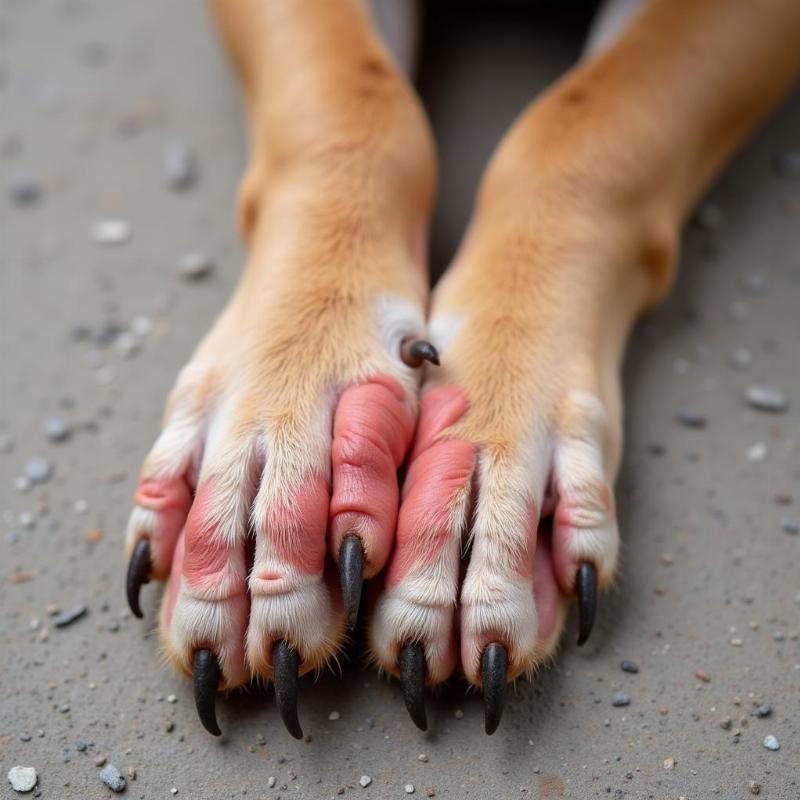If your dog flinches, pulls away, or shows aggression when you try to touch their paw, it’s a clear sign something’s not right. This behavior, often described as “dog won’t let me touch paw,” can stem from various reasons, ranging from minor injuries to underlying medical conditions. Understanding the root cause is crucial to addressing the issue effectively and ensuring your furry friend’s well-being. This article will delve into the common causes, diagnostic approaches, and treatment options, empowering you to provide the best care for your canine companion.
Why Won’t My Dog Let Me Touch Their Paw?
Several factors can contribute to a dog’s reluctance to have their paws handled. Identifying the specific cause requires careful observation and, in some cases, professional veterinary assistance.
Injury: The Most Common Culprit
One of the most frequent reasons a dog won’t let you touch their paw is an injury. This could be anything from a thorn or splinter lodged in the paw pad to a fractured toe. Look closely for any visible signs of trauma, such as swelling, redness, bleeding, or broken nails. Even seemingly minor injuries can cause significant discomfort.
Infection: A Hidden Source of Pain
Infections, whether bacterial, fungal, or parasitic, can also make paw handling painful. Yeast infections, for instance, are common between a dog’s toes and can cause itching, redness, and an unpleasant odor. Similarly, bacterial infections can result from cuts or punctures, leading to inflammation and pain.
Arthritis and Joint Issues: The Silent Ailment
Arthritis, particularly in older dogs, can cause significant joint pain, making even gentle touch unbearable. Other joint issues, such as hip dysplasia or elbow dysplasia, can also manifest as paw sensitivity, as dogs may shift their weight to compensate for discomfort in other areas.
 Signs of Arthritis in a Dog's Paw
Signs of Arthritis in a Dog's Paw
Past Trauma: The Lingering Effect
If your dog has had a negative experience involving their paws, such as a rough nail trim or an accidental stepping incident, they may develop a fear or anxiety associated with paw handling. This can manifest as avoidance, withdrawal, or even aggression.
Diagnosing the Problem: When to Seek Professional Help
While some minor injuries can be addressed at home, it’s crucial to seek veterinary care if your dog’s paw sensitivity persists, worsens, or is accompanied by other symptoms like limping, lethargy, or loss of appetite. A veterinarian can perform a thorough examination, including palpation, range of motion tests, and potentially X-rays or other diagnostic imaging, to determine the underlying cause.
What Will the Vet Do?
Your veterinarian will likely ask about your dog’s history, including any recent injuries or changes in behavior. They will then conduct a physical exam, focusing on the affected paw and surrounding areas. Based on their findings, they may recommend further diagnostic tests, such as blood work, skin scrapings, or joint fluid analysis.
Treatment Options: From Home Care to Veterinary Intervention
Treatment for paw sensitivity depends entirely on the underlying cause. Minor injuries may only require rest and gentle cleaning, while infections may necessitate antibiotics or antifungal medications. For arthritis and other chronic conditions, pain management and lifestyle adjustments are often key.
What Can I Do at Home?
If your dog has a minor injury, you can try gently cleaning the paw with warm water and a mild antiseptic solution. Avoid applying any human medications without consulting your veterinarian. If your dog allows it, you can also apply a cold compress to reduce swelling.
Conclusion: Providing Comfort and Care
A dog who won’t let you touch their paw is often communicating discomfort or pain. By understanding the potential causes and seeking appropriate veterinary care when necessary, you can help your furry friend regain comfort and mobility. Don’t hesitate to reach out to your veterinarian if you have any concerns about your dog’s paw health.
FAQ:
- How can I tell if my dog’s paw is injured? Look for signs like swelling, redness, bleeding, limping, or excessive licking.
- When should I take my dog to the vet for paw sensitivity? If the sensitivity persists, worsens, or is accompanied by other symptoms, seek veterinary attention.
- Can I give my dog human pain medication for their paw? Never give your dog human medication without consulting your veterinarian.
- What can I do to prevent paw injuries in my dog? Regularly check your dog’s paws for foreign objects, keep their nails trimmed, and avoid walking them on hot pavement or rough terrain.
- How can I make my dog more comfortable with paw handling? Positive reinforcement with treats and praise can help desensitize your dog to paw handling.
- Could my dog’s paw sensitivity be related to allergies? Yes, allergies can cause paw inflammation and itching.
- Is paw licking always a sign of a problem? While occasional licking is normal, excessive licking can indicate an underlying issue.
Beautdogs.us is your premier online destination for comprehensive and engaging information on dog care, breeds, and products specifically tailored for the US market. We offer expert advice on everything from nutrition and training to grooming and health, empowering both new and experienced dog owners to provide the best possible care for their beloved companions. For personalized guidance and expert insights, contact us today! Email: [email protected], Phone: +1 501-555-7529. Visit Beautdogs.us for more information.